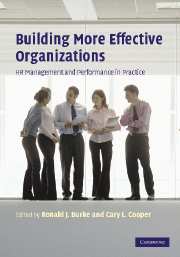Book contents
- Frontmatter
- Contents
- List of figures
- List of tables
- List of contributors
- Foreword
- Preface
- Acknowledgements
- Part I Building more effective organizations
- Part II Enhancing individual health and performance
- Part III Enhancing organizational health and performance
- Part IV Transforming organizations
- 12 Making it better – achieving outstanding performance in manufacturing organizations
- 13 Culture change in a financial services organisation
- 14 Building the sustainable organization through adaptive, creative coherence in the HR system
- 15 Be in to Win – from absence to attendance in Royal Mail Group
- 16 Transforming a company into a community
- Index
13 - Culture change in a financial services organisation
Published online by Cambridge University Press: 05 June 2012
- Frontmatter
- Contents
- List of figures
- List of tables
- List of contributors
- Foreword
- Preface
- Acknowledgements
- Part I Building more effective organizations
- Part II Enhancing individual health and performance
- Part III Enhancing organizational health and performance
- Part IV Transforming organizations
- 12 Making it better – achieving outstanding performance in manufacturing organizations
- 13 Culture change in a financial services organisation
- 14 Building the sustainable organization through adaptive, creative coherence in the HR system
- 15 Be in to Win – from absence to attendance in Royal Mail Group
- 16 Transforming a company into a community
- Index
Summary
Introduction
This chapter presents a case study of culture change in a large financial services organisation. The organisation under discussion is the second largest mutual building society in the UK, Britannia Building Society. Founded in 1856, Britannia employs in excess of 5,000 people, has over 3 million members and a network of over 250 branches.
In 2003 Britannia embarked upon a journey of organisational cultural change. This case study describes the approach and strategies adopted by Britannia in achieving cultural change and provides an overview of the implementation process. Although evaluation of the cultural change is in its infancy and is beyond the scope of this chapter, an outline of associated employee outcomes, in the form of employee satisfaction survey results, is provided.
Context for change
Unlike large-scale corporate change programmes, the rationale for culture change at Britannia was not rooted in a commercial crisis. Rather, there was recognition that the changes reshaping the financial services sector demanded a different type of organisation. The financial services sector was already experiencing far-reaching change. This included, for example, intensifying competition, new domestic and overseas competitors, and increasing product innovation.
Thus it was recognised that the culture and ethos of Britannia that had stood it in good stead for 147 years was now no longer appropriate. Success now required an organisation that was more flexible and better equipped to deal with structural market change.
- Type
- Chapter
- Information
- Building More Effective OrganizationsHR Management and Performance in Practice, pp. 293 - 309Publisher: Cambridge University PressPrint publication year: 2007



